The law of the jungle
This article was written by Christopher Sheldon, Kevin McMahon and Kristopher Novell
As we engage with our investors during these uncertain times,
we are often asked, “Where are you seeing the most attractive
relative value opportunities?” The short answer is that we believe
there is a lot of “best” relative value in the marketplace today:
Different kinds of credit opportunities can suit the different
aims of different investors. However, we do have a few key
takeaways to help frame what may be optimal for your portfolio:
- We believe credit is going to be more attractive than equities over the medium term, with yield a valued differentiator at a time of slowing growth and higher inflation. In the short term, investors can get an extension of yield at current levels through call protection, which can be valuable.
- Deciding where to allocate within Credit depends on individual requirements for volatility, duration risk, liquidity, return levels, and the trade-offs between returns and seniority within the capital structure.
- Short-term volatility isn’t a good reason to delay investing in Credit, as the drivers are typically transient and liquidity dries up quickly when the market bottoms. When the Credit market rallies, it tends to happen rapidly, and market levels usually bottom out before fundamentals.
- There are risks to our view but we believe these are largely mitigated. The main risk is a severe slowdown in terms of fundamental performance in corporate credits. We note that revenue and EBITDA levels are slowing, but remain robust. While rising interest rates are unlikely to cause repayment or refinancing issues for the average issuer of a sub-investment grade credit, bottom-up analysis is vital to identifying the outliers that will come under pressure.
Uncertainty, lack of visibility and fear of the unknown are all
reasons we have heard quoted by some market participants
for not investing in credit markets at present. One recently
remarked that it felt like walking through a jungle; if you
are not aware of the surroundings, it will seem dangerous.
However, if you are familiar with the terrain, it will not seem
half as scary.
As we reflected on this and on our last letter, where we
bemoaned the lack of leadership in markets, we decided to
heed the advice of Rudyard Kipling. In “The Jungle Book,”
Bagheera the Panther reminds Mowgli that the Law of the
Jungle is to strike first and discuss later. So, that’s what we did.
Rather than talk about the lack of “striking” going on, we want
to talk about the actions we are taking and why.
Key Themes
As we look across the market, we will cover the following themes:

1. Why We Believe Credit Is Attractive Now
We have high conviction on the direction of travel in today’s Credit markets: We believe over the medium term Credit is going to become more attractive relative to equity and yield will be more valuable (Exhibit 1). As a result, Credit is likely to become a more significant part of asset allocation in the future relative to the last 10 years. The long-term forces driving this shift are:
- Markets use long-term Treasuries as a proxy for the risk-free rate in pricing risk assets.
- Central banks introduced quantitative easing (QE) to prevent deflation after the global financial crisis (GFC).
- QE pushed the risk-free rate toward zero in many developed markets and below zero in Europe. Asset values soared.
- As QE comes to an end, the discount rate is going up and the value of risk assets is going down.
- We do not see this changing while inflation remains high and expect a “higher resting rate” for inflation and interest rates more generally.
As markets adjust over the medium term, we believe there
is a lot of value to preserving high current yields on debt
through call protection. Ultimately, we believe that investing
to extend the period of earning higher income is a strategy
that will outperform, especially at a time of low economic
growth. In deciding how to allocate, we think the key factors
are investment aims and time.
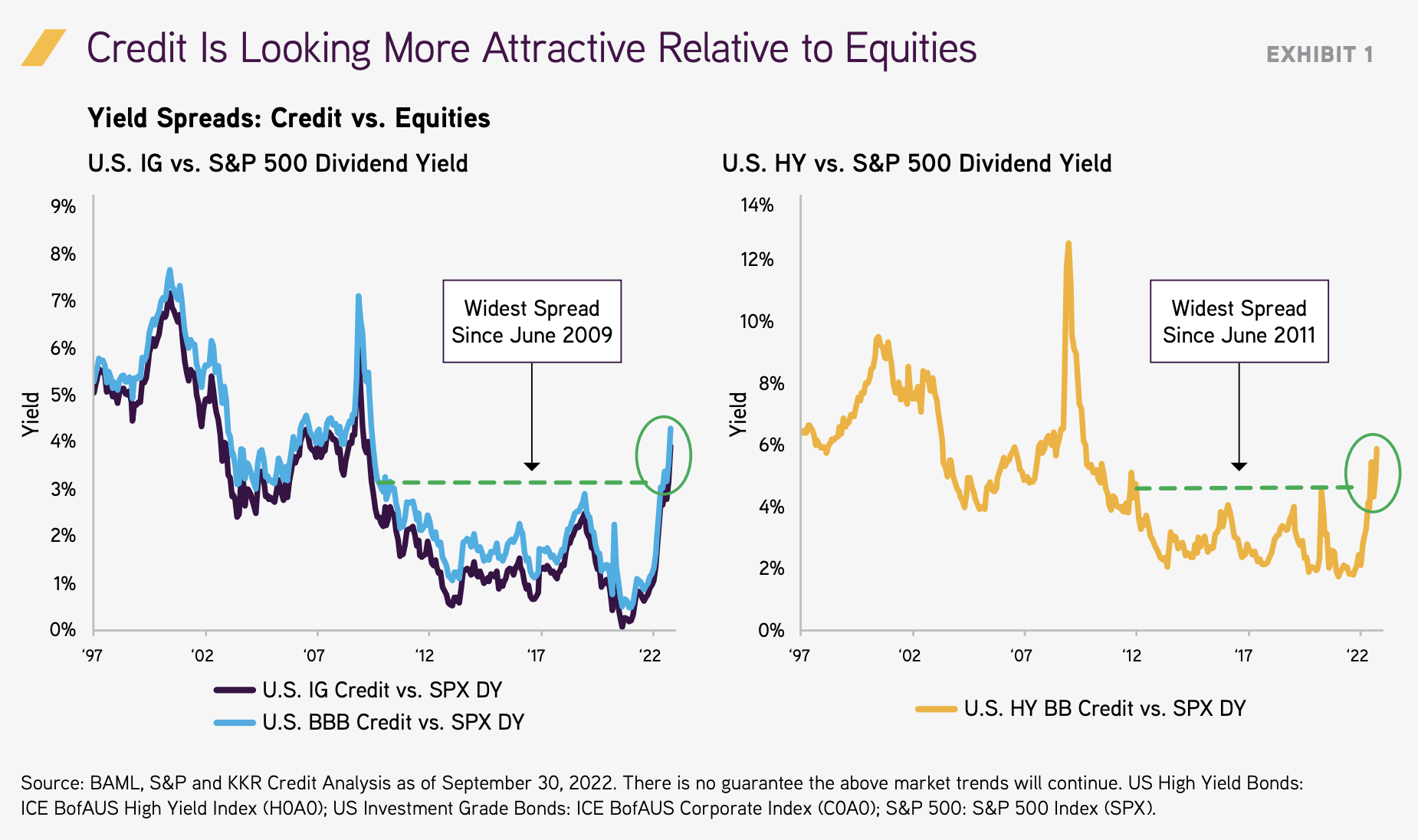
2. Investment Aims and Time
Many investors have told us over the last few months that
they are delaying Credit allocations until a more attractive
entry point appears. We believe timing the market is hard:
Credit markets move fast, and liquidity tends to dry up at the
bottom (Exhibit 2). Given the fact that liquidity is some 65%
of where it was a year ago (Exhibit 3) and there is a severe
shortage of net supply (Exhibit 4), there is a premium for
providing liquidity to this market. We are starting to lean in
and think it’s prudent to be ready to buy on the way down,
or even better, to continually leg into a Credit allocation. It
takes time to deploy in this market. While we believe current
prices in traded credit may signal that the market is “on-sale”, we want to stress that the market is not “for sale.”
This is a liquidity-driven and credit-driven dislocation.
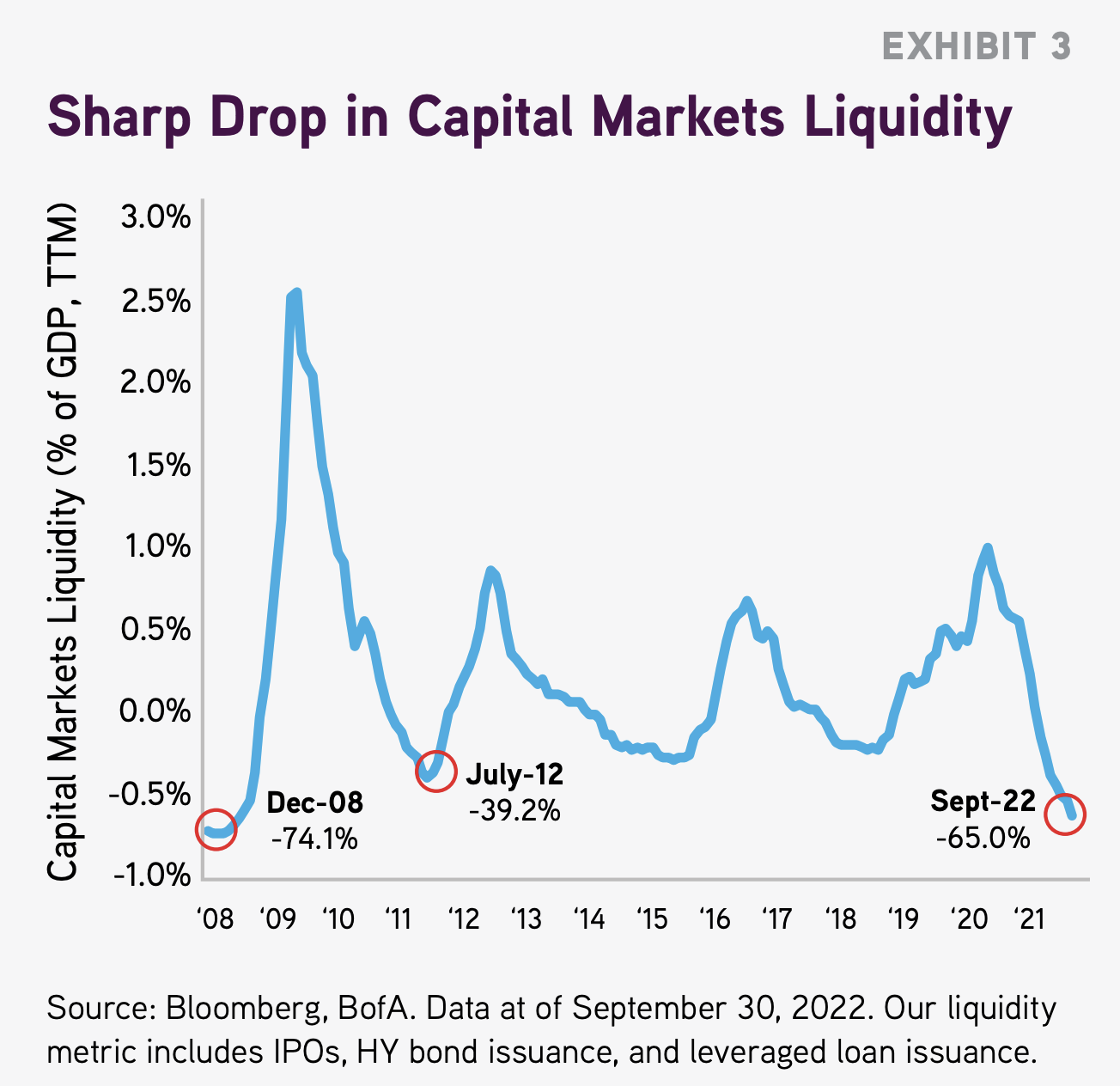
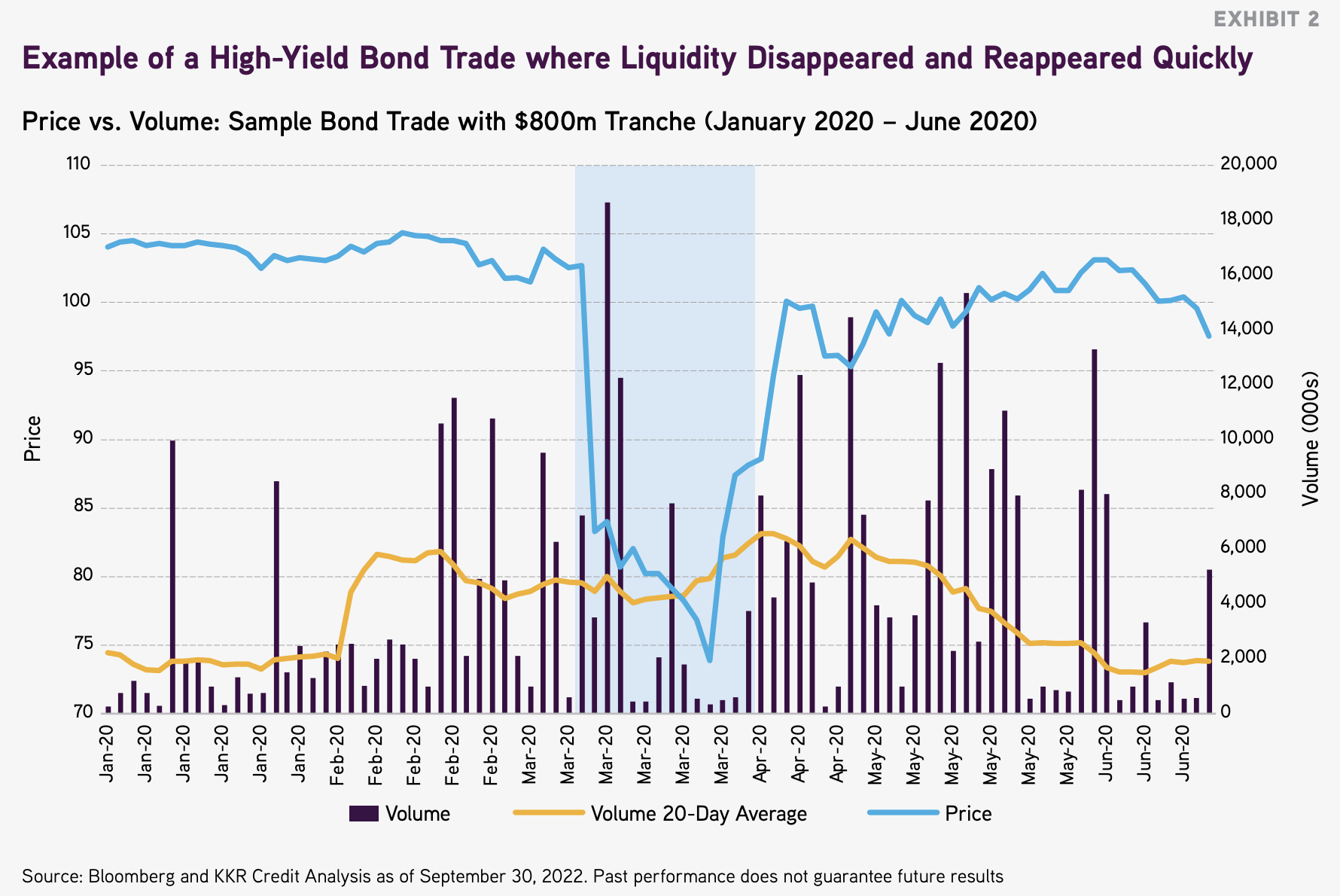
When liquidity dries up to such an extent, any rally in Credit
due to sentiment or inflows can cause a violent rally in spread.
If we look at Exhibit 5, we can see that even a small level
of inflows resulted in a spike in return in high yield in July.
When there are sustained inflows again or a more balanced
liquidity picture we expect this market to rally hard and rapidly.
It will likely be too late for most investors to access either this
convexity or extended yield unless they are already invested.
The decision to leg into Credit now is even more pronounced
in private credit, where ramp-up times can be over a multiyear horizon. A few months ago, some market-observers felt
that spreads in private credit had not adjusted to the same degree as public credit, and therefore weren’t worth paying
attention to. While the part about spread adjustment was true
at the time, and relative price stability is part of what makes
private credit attractive, an adjustment in new issue private
credit spreads was always likely to occur in a quarter or two,
which is significantly less time than it would take to deploy a
meaningful amount of capital. We should note that this spread
adjustment has now occurred (Exhibit 6), and we expect
private credit valuations to stay attractive for the medium
term. Exhibit 6 shows the overall adjustment in value for our
investors over the year in senior direct lending. We continue
to deploy on their behalf.

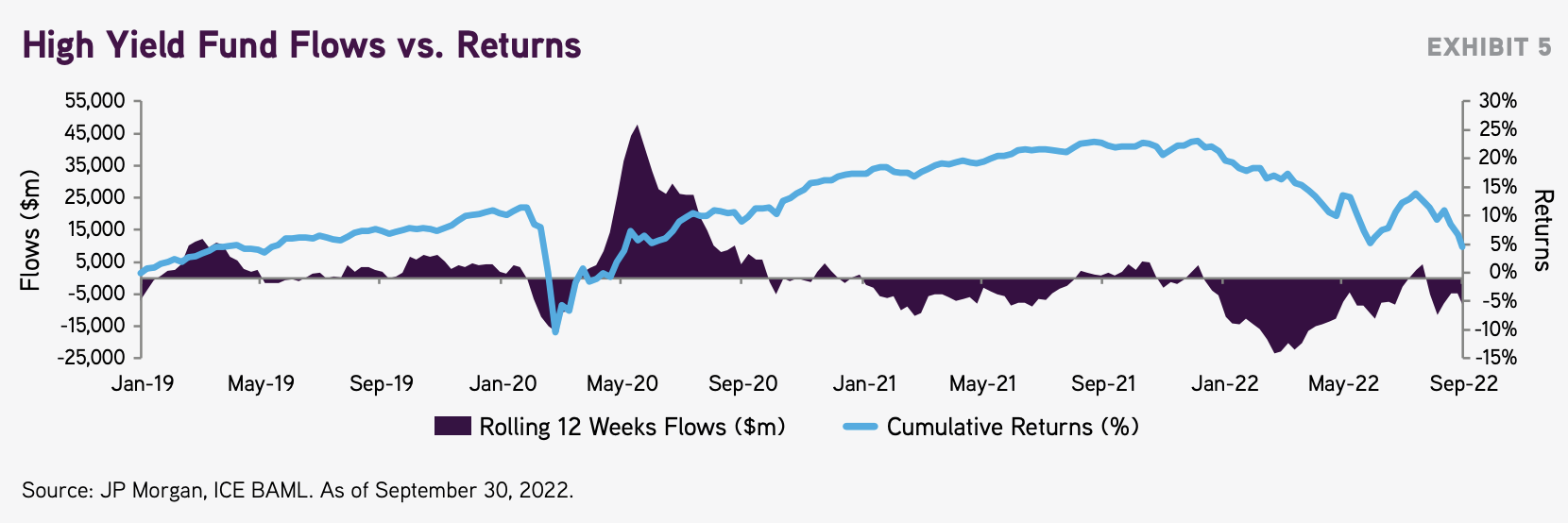
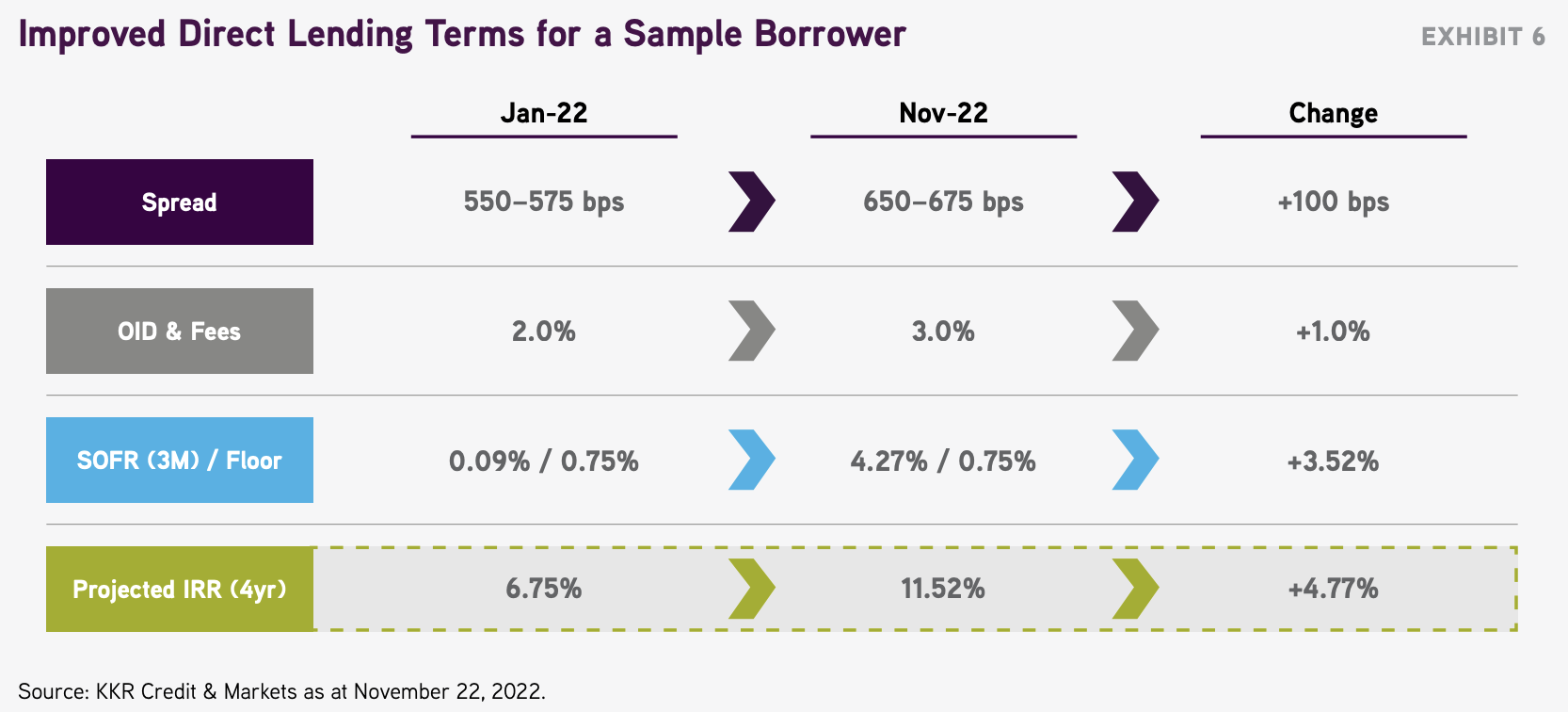
We expect the opportunity set to rotate as the market
normalizes. For example, hybrid capital solutions are an
area of strong risk-reward today. Some investors have an
immediate desire for capital, but find that traditional financing
routes for equity and debt remain closed to them. The ability
to provide solutions to these companies is valuable.
In contrast, deployment in junior debt behind large syndicated
senior debt transactions is limited at the moment, mostly
because of a decline in mergers and acquisitions. However,
when this changes we expect very attractive overall yields,
as the supply of capital will be limited. Since markets can
reopen quickly, we think it is wise to examine this space now
and consider making a commitment that will be deployed
over the next two-to-three years. This is even more
attractive considering that investors in this market will likely
benefit from standard call protection at current spread.
Let’s use a simple example of a business paying SOFR plus 5% cash, plus 5% PIK for a mezzanine loan today. If we assume 3% of upfront fees and non-call protection for two or three years with 104 premium in year three or four, this investor would benefit from a minimum multiple-of-money of over 1.5x–1.6x after a three-or-four-year period at current interest rates.
While we are actively telling investors to avoid trying to time the Credit markets, we understand that some see delaying the decision to invest as a way to avoid the pain of volatility. More important than timing, however, are the overall investment aims of the portfolio. Put another way, what are the factors of return that allocators are trying to maximize? A few questions can help in thinking this through:
- Is there a need for access to liquidity?
- Is there a threshold for price volatility?
- What is the outlook for fundamentals, and is there a need to focus on security of position?
- Where will interest rates go, and is there a desire to take duration risk?
- Is there a preference to maximize IRR or multiple of money?
We have mapped out in Exhibit 7 how these different
considerations can skew the attractiveness of different asset
classes today. This list is not an exhaustive one, and the
scores here are subjective, but we use this exhibit to make
the points that a) an assessment of relative value today can
depend on an investor’s desires, and b) these assets do have
different characteristics of risk and return.
As the chart shows, no one asset class has a line closest to
the center or to the outside. In short, all these asset classes
exhibit different risk and return characteristics, and investors
should bear them in mind relative to their aims.
One area we want to touch on is the convexity of return.
Syndicated loans have more potential for short-term
convexity at an average price of 92.5%, but private credit
offers the potential for higher and more stable income over
the forecast period. This is even more pronounced as we
consider the fact that call protection is extremely valuable
at these spreads. Call protection is not a significant factor
in syndicated loans, but is very prevalent in private credit,
especially junior debt and high yield.
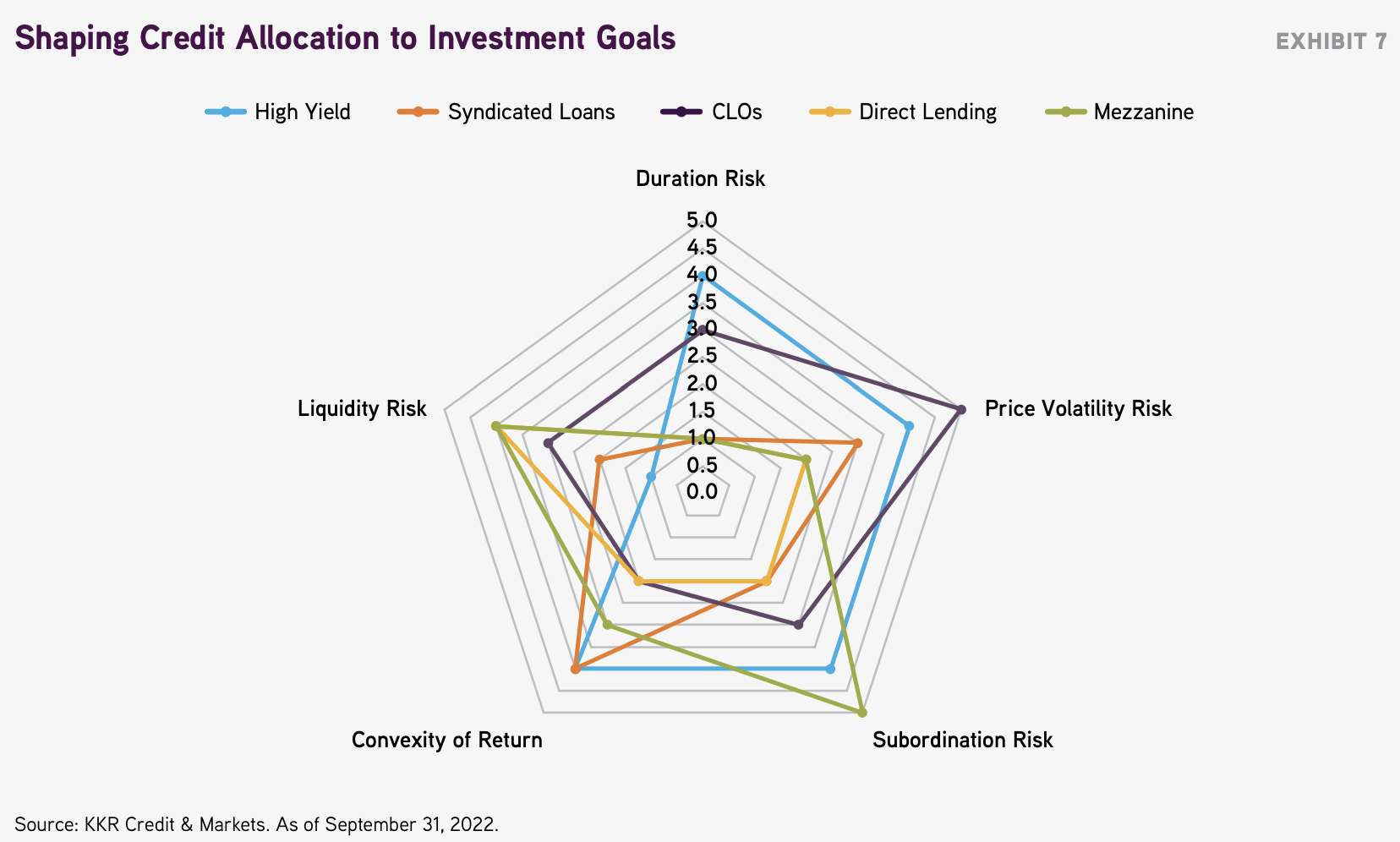
3. The Value of Flexibility
Our analysis until now has focused on comparing different asset classes. However, we should point out that value is rarely this linear. Even within asset classes there are some pockets of dispersion that will offer extreme value for a short period of time—usually for transient reasons that disproportionately impact investor sentiment and supply/ demand factors. Two good recent examples are:
- The U.K. mini-budget from Liz Truss’ government sparked a crisis in sterling markets and ultimately triggered significant selling from pension funds employing liability-driven investing. U.K. pension funds have historically been buyers for CLO liabilities, and their selling meant a spike in yields (Exhibit 8).
- Within the high yield market, there is a structural aspect within the market which has resulted in the spread ratio between CCC and BB bonds peaking close to historical highs (Exhibit 9). Meanwhile the spread between BB and BBB has been tightening as BB spreads contract and BBBs widen. Investors are being paid if they know a credit’s fundamentals and do not have to sell on the basis of its rating or weight in an index.
Given these examples, and there are others within individual
sectors and asset classes, we believe the ability to be
flexible and pivot to where temporary opportunities present
themselves is valuable. We are seeing more interest in multiasset class mandates and investors looking to maximize
alpha by acting as a liquidity provider across asset classes.
This is all the more powerful if the mandate does not include
a requirement to track a broad index. Flexibility in terms of
mandate is valuable. The capital markets remain largely shut,
as shown in Exhibit 2. Lenders that can provide innovative
solutions to companies seeking capital are likely to find they
can access companies that would have been within the sole
purview of the public markets. A good recent example was
our transaction with Skydance, about which more details are
available here.
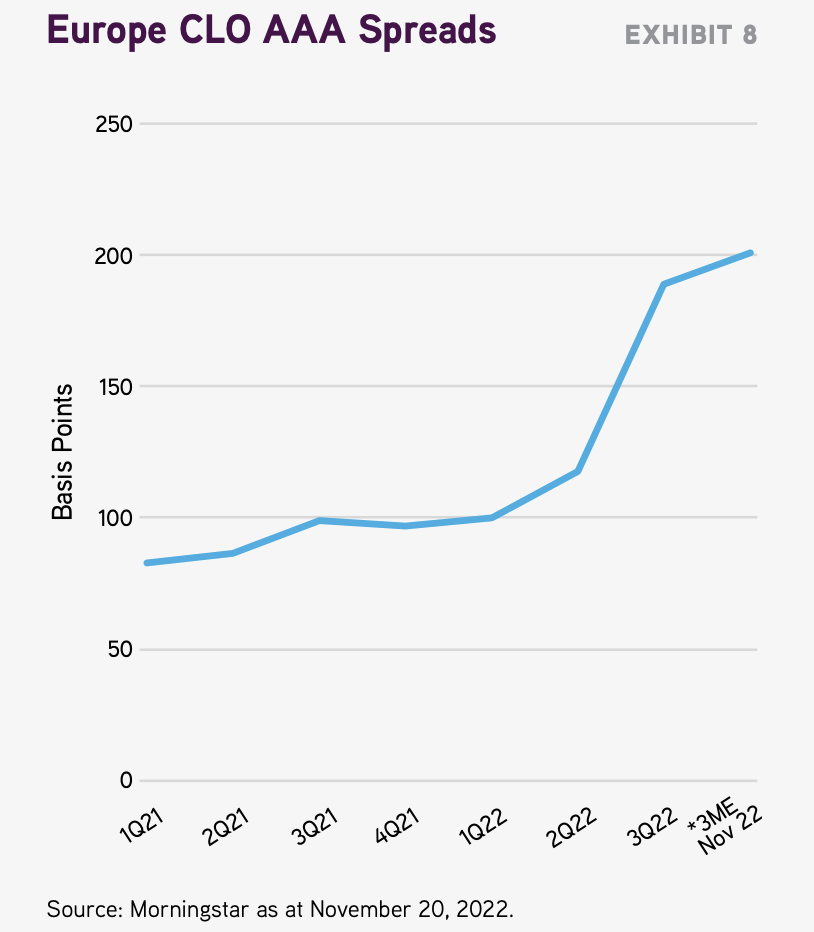
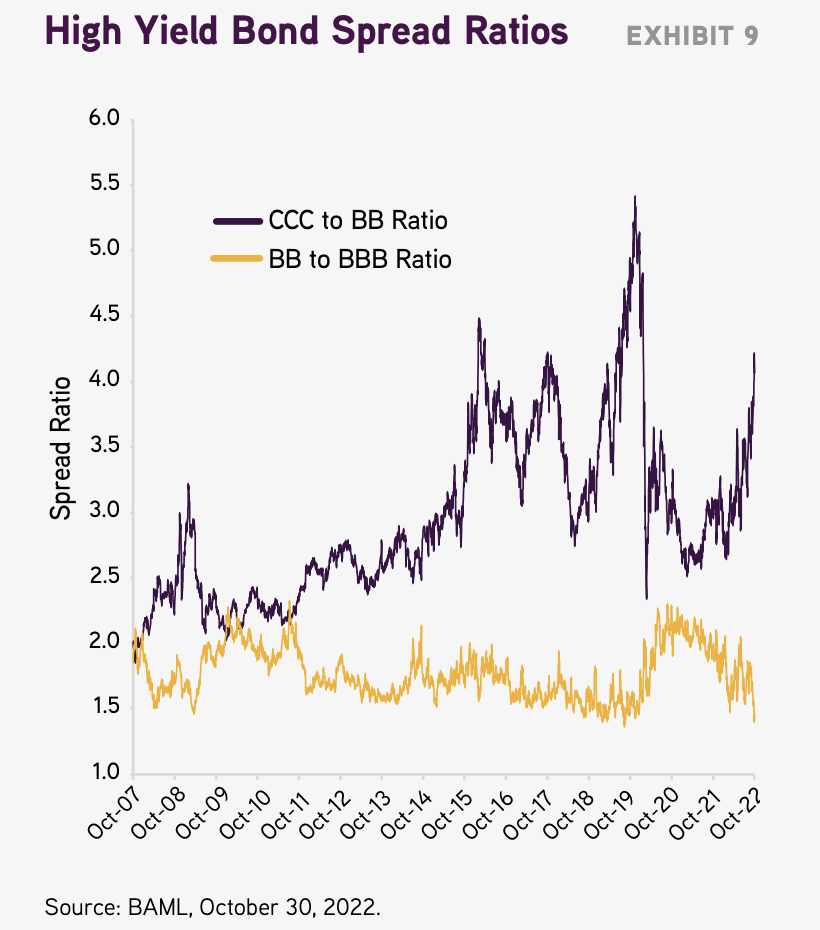
4. There Are Risks
The examples we have presented so far and many others we didn’t discuss reinforces our belief that it is an attractive time to start legging into Credit more broadly. However, there are some risks that investors are conscious of.
a) Slowing Fundamentals
The revenue and EBITDA trends (Exhibits 10 and 11) across
the 1,800 names (spanning 25 industries and some 40
countries) in the KKR Credit portfolio shows that growth is
slowing. There is a risk that this slowdown could accelerate.
Revenue and EBITDA growth rates over the past three
months are lower than over the last 12 months, though
revenue growth over the last three months was still some
15% higher than the year before. EBITDA growth rates are
lower than they were a year ago, indicating that margins are
contracting. Indeed, overall EBITDA rose just 7% in the last
three months over the previous three-month period.
Exhibit 12 compares EBITDA performance over the last 12 months and last three months by sector. When a sector shows up below the 45-degree line running through the chart, it means that EBITDA growth momentum is slowing. Most sectors fall into this category.
The size of the bubbles in Exhibit 12 represents KKR’s
own exposure to the sector, which we present mainly to
show where we think risks and opportunities lie. We are
underweight more volatile areas (utilities, energy, auto)
and overweight areas that have had relatively stable
earnings momentum (software, healthcare, capital goods
and consumer service). This again highlights the value of
selectivity and flexibility discussed in Section 3.
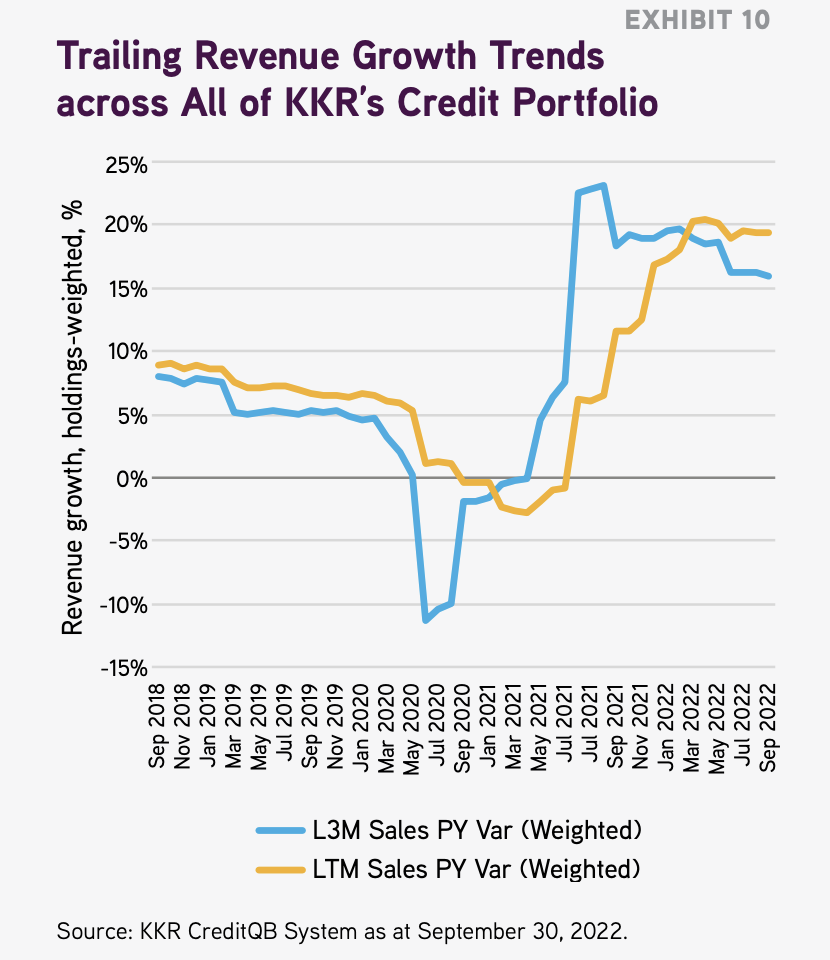
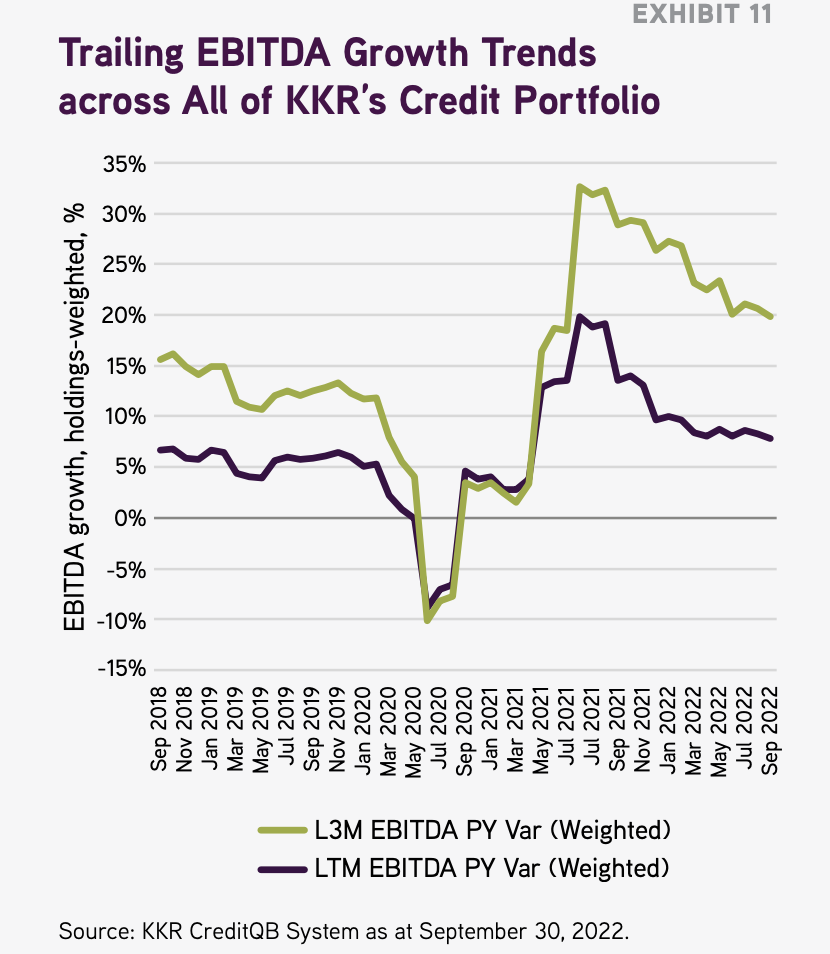
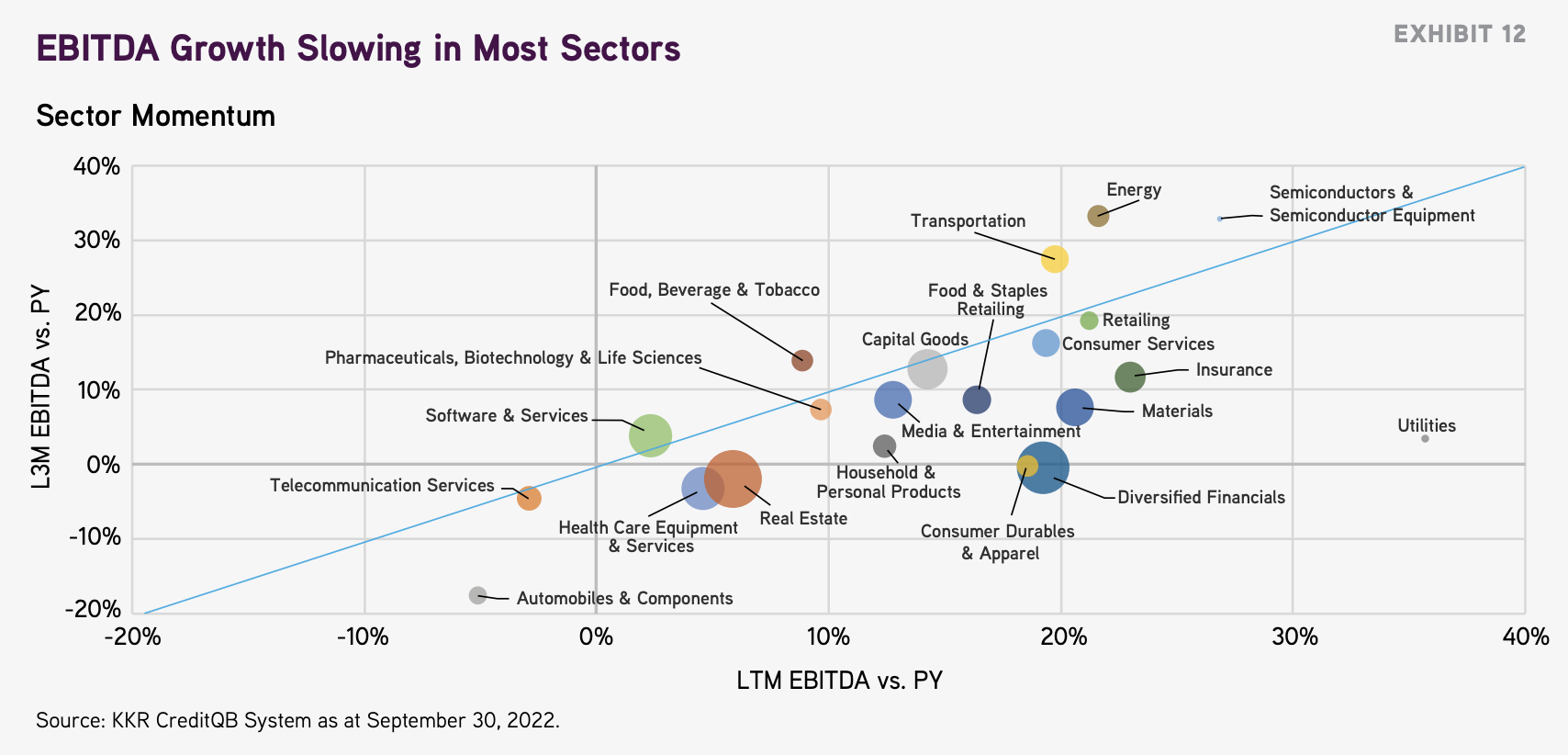
We have also been selective about the companies we lend
to, favoring firms that are large (average sales of a portfolio
company is $3.8 billion with average EBITDA of $700
million over the last 12 months) and have both defendable
margins and strong market positions. These efforts to
minimize downside risk make it more difficult to generalize
our experience to that of the broader market, but we do not
foresee a significant or imminent increase in defaults in our
portfolio based on fundamental performance.
b) Higher Rates from Here
Higher interest rates are another source of risk to Credit portfolios. Floating-rate credits have a different set of considerations when it comes to interest rate risk. Our direct lending portfolios are a good proxy for our broader position in syndicated loans. Exhibit 13 shows the weighted average interest coverage in FSK, our $17 billion listed business development company (BDC). The average interest coverage is 2.5x at interest rates of 3.75% as of early November. This means that these companies are generating 2.5x free cash flow relative to servicing interest. If we were to stress test this to the highest point on the forward curve (5.2% as of November), the companies in the BDC would still generate 2.2x interest coverage. Even assuming base rates rise an additional 3% to 6.75%, the companies still generate 2x as much cash as they need to pay debts.
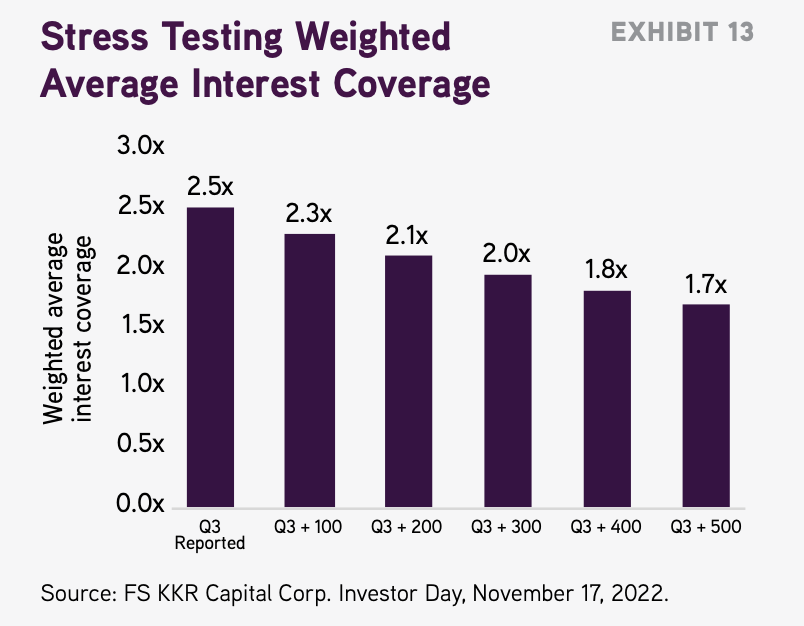
We expect the vast majority of companies in our portfolio to
be able to service interest and pay maintenance capex even
in a stress scenario with significantly higher interest rates.
However, these tests show why we have an underwriting
bias toward high-margin companies with stable cash
flows and away from high-growth companies in need of
significant capex. With respect to the broader market, we
should add that we do expect market defaults to increase
over time, but don’t envision a spike.
c) Capital Markets Remain Shut
As we discussed earlier, lower transaction volumes in capital markets provide an opportunity for private market issuers.
However, it also poses a risk to public credit borrowers
who cannot repay all their debt from free cash flow and
require financing. If we look at the roughly $3 trillion of
sub-investment grade loans and bonds outstanding in the
U.S., we don’t see any imminent issues in meeting these
obligations for the average borrower that is due to mature
over the next few years (Exhibits 14 and 15). However,
we believe that some individual companies in the broader
market will likely struggle to repay or refinance. There is no
substitute for robust bottom-up analysis to identify and avoid
these names. Similarly, if capital markets were to remain shut
until, say, 2025, by which point more than 20% of the market
will have matured, more names may be forced to default.
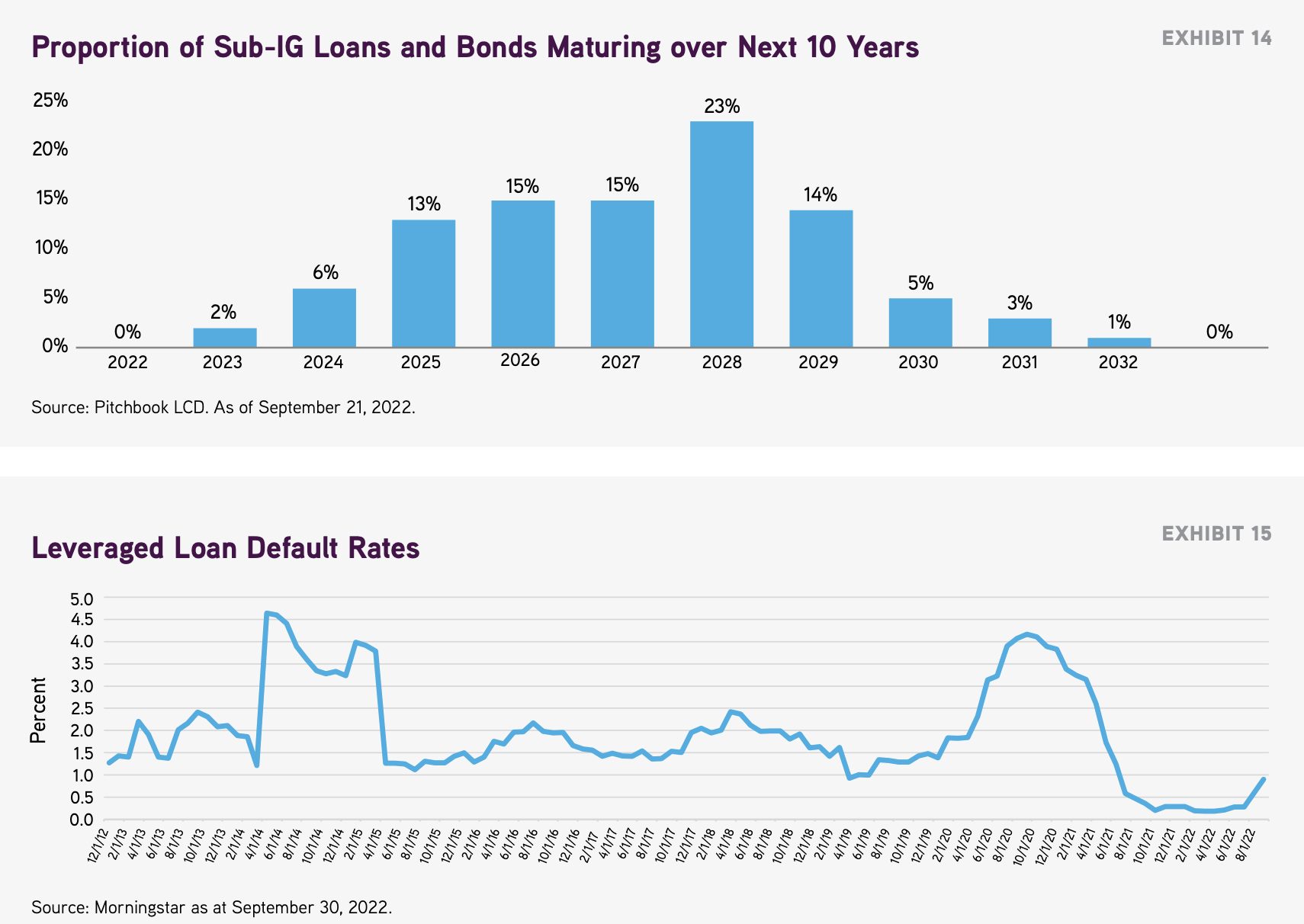
d) Demand from Traditional Avenues Continues
to Be Depressed
As we have witnessed in the last six months, both loan and CLO prices have been impacted by a lack of new CLO issuance. If the CLO market were to remain shut for a sustained period of time we would expect loan spreads to remain elevated in order to attract new capital to the market.
Similarly, as we have seen in markets like the U.K., Australia, and Japan, FX volatility and a need to cover U.S. dollar hedges as the dollar strengthens can force large SMA buyers to become net sellers in order to meet liquidity needs or to rebalance their allocations.
If the U.S. dollar continues to strengthen, we would expect
more selling and a longer wait before these buyers re-enter
the market given the scars of selling assets at a time of low
liquidity and wide bid-to-order spreads.
In private credit, too, capital formation is slowing, and there are signs of a lack of leadership in a space where we had seen a lot more leadership in recent years. We continue to be prudent and selective in terms of origination. As we discussed in Section 1, we do believe it is time to start striking and legging in to a private credit allocation.
e) A Sharp Rally
We have been advising investors to begin to leg into Credit. This view is partly based on the fact that, in private credit at least, it can take time to deploy capital. As we alluded to in the first section, if central banks pivot or there is a change in sentiment that leads to inflows at a time of low liquidity, credits will likely rally toward par rapidly. We should note that we do not expect this to happen in the short term—at least until there is greater consensus in the market and more leaders begin to strike.
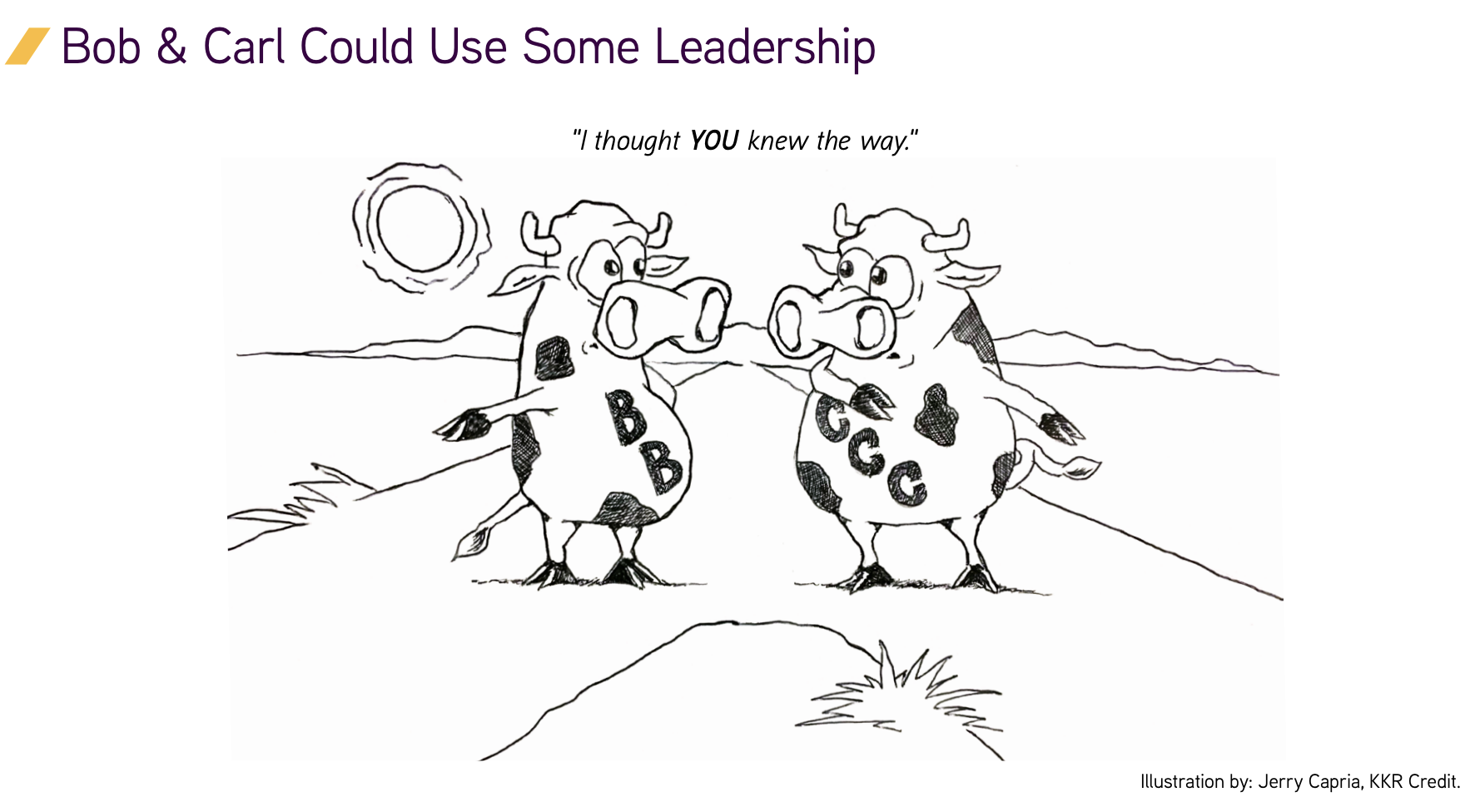
Conclusion
“To each his own fear.” —Baloo the Bear
In volatile times, instincts like fear can take over. Naturally, investors want to know where to hide during the storm and when it is time to come out and pick the fruits that have fallen to the ground. Many times, their questions tend to focus on what asset class is the “best” for the moment. Our hope in this letter is to provide a framework for investors to see the value in Credit more broadly and consider what different types of assets can play different roles and fit different investment aims and time horizons. There is no absolute “best,” but there are smart ways to identify investment needs and carefully choose the right asset mix for today. We emphasize the present, we do feel there is a lack of liquidity at the moment and investors can get paid a credit premium for providing this to borrowers. So we are recommending investors to leg into the current market. In terms of where to start investing, we point to the following:
1) Liquidity is low in markets, and fundamentals are stable, so we expect that the Credit markets are likely to rally hard when sentiment changes. This could happen very quickly. Investors could miss the current opportunity if they try and time the market.
2) Private credit can take time to deploy, so committing to deployment now can allow investors to average into current attractive spreads over the next two-to-three years and benefit from call protection to maximize money multiples for investors.
3) There is dispersion in performance and across sectors. We also expect pockets of dislocation across private and public credit—so investing in flexible mandates rather than buying beta can be valuable to investors.
4) We believe a broad mandate is beneficial, especially when market depth is limited and there are creative avenues to be a “solutions provider” for issuers who are seeking access to capital, but closed out of traditional financing routes.
Learn more about investing in credit
For further insights from one of the world's most recognisable names in private equity and alternative investments, visit the KKC Australia website.

3 topics
1 stock mentioned
1 fund mentioned

